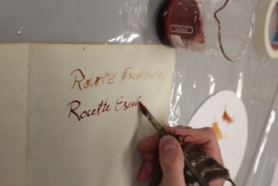Events
Joint NICAS/TAH-COLLOQUIUM, 22 February, Amsterdam
 The Technical Art History Colloquium is organised by Sven Dupré (Utrecht University and University of Amsterdam, PI ERC ARTECHNE), Arjan de Koomen (University of Amsterdam, Coordinator MA Technical Art History), Abbie Vandivere (University of Amsterdam, Coordinator MA Technical Art History & Paintings Conservator, Mauritshuis, The Hague), Erma Hermens (University of Amsterdam and Rijksmuseum) and Ann-Sophie Lehmann (University of Groningen). Monthly meetings take place on Thursdays.
The Technical Art History Colloquium is organised by Sven Dupré (Utrecht University and University of Amsterdam, PI ERC ARTECHNE), Arjan de Koomen (University of Amsterdam, Coordinator MA Technical Art History), Abbie Vandivere (University of Amsterdam, Coordinator MA Technical Art History & Paintings Conservator, Mauritshuis, The Hague), Erma Hermens (University of Amsterdam and Rijksmuseum) and Ann-Sophie Lehmann (University of Groningen). Monthly meetings take place on Thursdays.
The NICAS Colloquium is a bi-weekly lunch meeting, organized by Katrien Keune (Rijksmuseum, University of Amsterdam) and Ella Hendriks (University of Amsterdam), providing a platform to stay informed about the latest developments and results and to exchange information and expertise between the fields of science, conservation and art history.
Please download the invitation for the 22nd February edition here.
The Mayerne Manuscript: text – object – method
Jenny Boulboullé
This presentation focuses on MS Sloane 2052, better known as the ‘Mayerne Manuscript’, that has gained fame as an indispensable handbook for the study of Netherlandish painting. I discuss the making of the Mayerne Manuscript from its original compilation (1620-1640) to its publication in print in the long nineteenth century up to its current use for teaching and reconstruction research in conservation studies and technical art history, and its recent digitisation. While the recipes and technical instructions contained in the Mayerne Manuscript have a long reception history, the manuscript has rarely been studied as an early modern artefact or as part of early modern material knowledge cultures. I portray the Mayerne Manuscript as a historical object with its own rich cultural biography. Moreover, I make a case for art technological source research and material-technical approaches as integral part of interdisciplinary research in art history, material culture studies, and history and philosophy of science.
Imaging, Identification and Interpretation of Glass in Paint
Erma Hermens
Painters from medieval times onwards used tricks to improve optical and handling properties of their paints. Historical treatises and manuals on painting techniques provide some insights into these methods. The extensive presence of ground colourless and sometimes coloured glassy particles in paint layers belongs to the more elusive painters’ ‘secrets’. From Murano to the Netherlands, Simplicia cabinets and apothecaries’ pricelists, there are many testimonies for this trick-of-the-trade. Yet, although ground glass is ubiquitous in paint layers of 15th to 17th- century European paintings, its role in practical, conceptual, and aesthetic sense is little researched and contextualised. The painter’s choice to add ground glass, either colourless or coloured, evokes questions concerning the optical impact, transparency and mimesis, and functionality, as well as crossovers with the glass and ceramics industries, which will be the focus of a NICAS Seed Money project.


